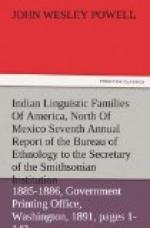[Footnote 10: Gibbs in Pac. R. R. Rep. I, 1855, p. 428.]
[Footnote 11: Lewis and Clarke, Exp., 1814, vol. 2, p. 382.]
[Footnote 12: Gatschet and Dorsey, MS., 1883-’84.]
[Footnote 13: Dorsey, MS., map, 1884, B.E.]
[Footnote 14: Hamilton,
MS., Haynarger Vocab., B.E.; Powers,
Contr. N.A. Ethn.,
1877, vol. 3, p. 65.]
[Footnote 15: Dorsey, MS., map, 1884, B.E.]
[Footnote 16: Powers, Contr. N.A. Ethn., 1877, vol. 3, pp. 72, 73.]
[Footnote 17: Powers, Contr. N.A. Ethn., 1877, vol. 3, p. 114.]
[Footnote 18: Powers, Contr. N.A. Ethn., 1877, vol. 3, p. 122.]
Southern group.—Includes the Navajo, Apache, and Lipan. Engineer Jose Cortez, one of the earliest authorities on these tribes, writing in 1799, defines the boundaries of the Lipan and Apache as extending north and south from 29 deg. N. to 36 deg. N., and east and west from 99 deg. W. to 114 deg. W.; in other words from central Texas nearly to the Colorado River in Arizona, where they met tribes of the Yuman stock. The Lipan occupied the eastern part of the above territory, extending in Texas from the Comanche country (about Red River) south to the Rio Grande.[19] More recently both Lipan and Apache have gradually moved southward into Mexico where they extend as far as Durango.[20]
[Footnote 19: Cortez
in Pac. R. R. Rep., 1856, vol. 3, pt. 3,
pp. 118, 119.]
[Footnote 20: Bartlett,
Pers. Narr., 1854; Orozco y Berra, Geog.,
1864.]
The Navajo, since first known to history, have occupied the country on and south of the San Juan River in northern New Mexico and Arizona and extending into Colorado and Utah. They were surrounded on all sides by the cognate Apache except upon the north, where they meet Shoshonean tribes.




